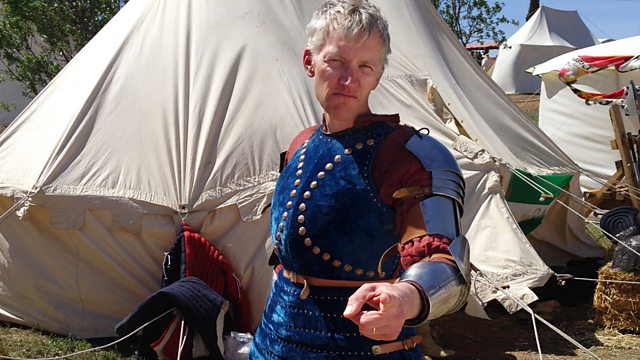Church Pews and the Medieval Weather Forecast
Tom Holland takes a back-side view of church architecture, and Helen Castor tunes in to the medieval weather forecast.
Tom Holland presents the history programme which connects the past with today.
Enthusiasts for Victorian church architecture are furious that the pews designed by Sir George Gilbert Scott in Bath Abbey have been dismantled and removed and are to be sold. Supporters of the plan say that it will create a huge space which the Abbey can then use for community events. Of course, back in medieval times most churches had no furniture, so why was it introduced and what can it tell us about the people that installed and sat on it? Iszi Lawrence visits Somerset to find out more.
It's the season of village fetes, country fairs, music festivals, cricket and world-class tennis and everyone is more than usually interested in the weather forecast. We think of this as a very modern service and are amazed even at the accuracy of meterologists during the planning of D-Day in 1944. But weather forecasts have been made for centuries and those making them knew more about the science behind them than we may think. Helen Castor visits Merton College Library in Oxford, which in the fourteenth century was the Met Office of its day.
Producer: Nick Patrick
A Pier production for ����ý Radio 4.
Last on
More episodes
Guests
��
Tom Holland is joined by from the University of Birmingham.
Church Pews
A legal row between and has concluded with the Abbey winning the right to and create more flexible use of space in the medieval building by using chairs that can be stacked away when there is no service. It’s a row that dragged on for years and reflects a growing trend up and down the country. But, before the few, if any, churches had pews. So, where did they spring from and why?
��
Iszi Lawrence travelled to the village of near Taunton to meet Doctoral student Susan Orlik from the who has written her thesis on church pews. Here, in the parish church, there are ��that survive from the years before the Reformation and just after it.
��
Mediterranean Migration
Current estimates suggest that 1,000 people have lost their lives this year as part of the ongoing across the Mediterranean. There seems no end to this human misery and it is impacting on politics throughout Europe. The Mediterranean has been a thoroughfare for the movement of goods and people for two millennia or more but, in our heads perhaps, we are most familiar with the idea of people moving from south to north. But, back in the , the direction of movement was reversed as economic conditions, religious persecution and even the weather forced people to start new lives in North Africa and the Ottoman Empire.
��
This new take on an old story is the focus of research, funded by the EU, by ����at the���� as she explained to Tom Holland.
��
The Medieval Weather Forecast
We tend to think of the as an age before science, an age when the weather and natural disasters were a sign ‘from God’. That, of course, is a gross over-simplification, one that is being disproved by new work on a group of scholars at who, in the fourteenth century, were making advanced .
��
This research is being carried out by at the University of Reading which is drawing on papers and artefacts held at and libraries.
��
��
Making History is produced by Nick Patrick and is a Pier Production for ����ý Radio 4
��
Broadcasts
- Tue 10 Jul 2018 15:30����ý Radio 4 FM
- Thu 20 Sep 2018 23:30����ý Radio 4
Podcast
-
![]()
Making History
Popular history series where the past connects with the present.


